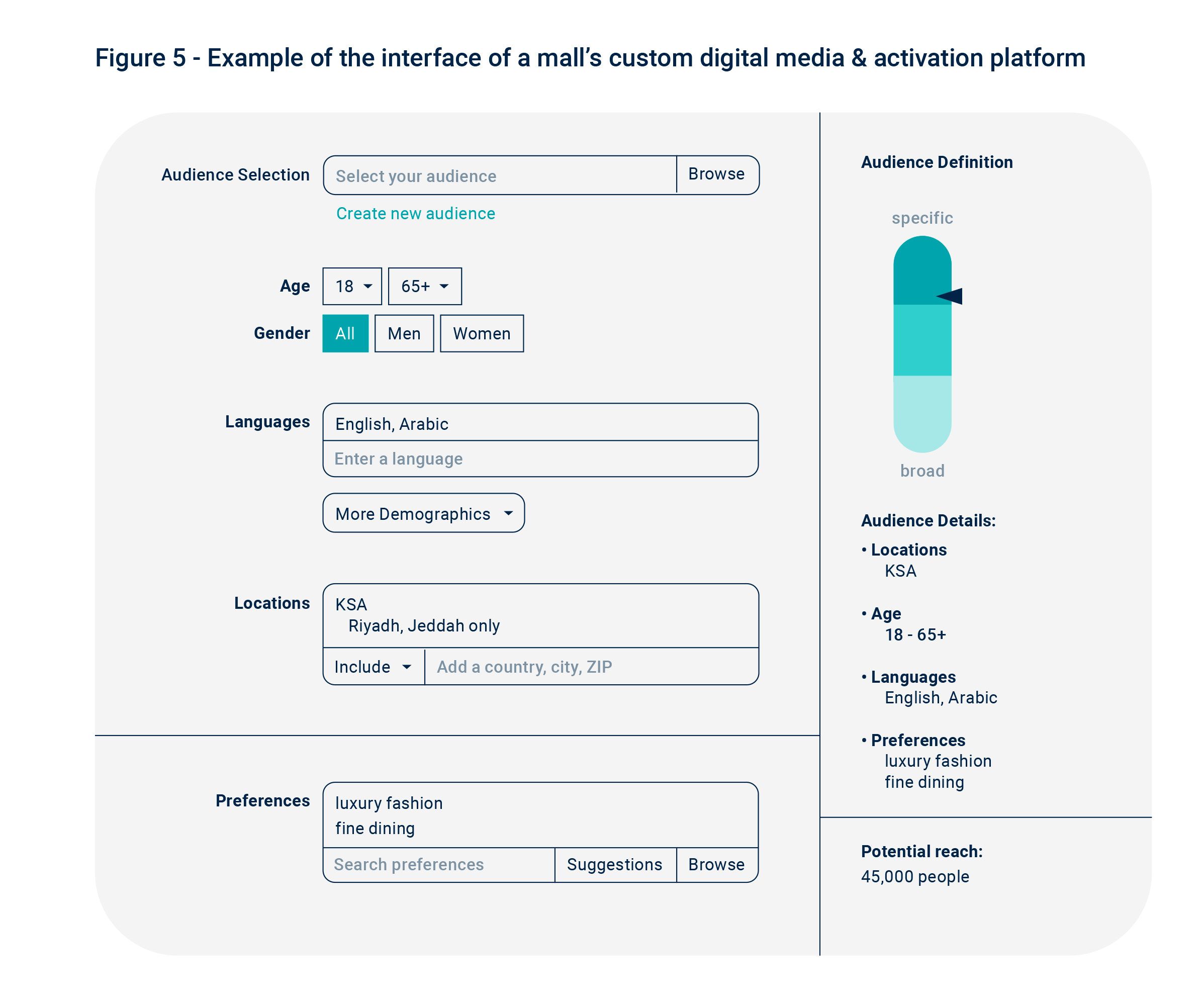"Pour survivre après la pandémie, les centres commerciaux du Moyen-Orient doivent adopter l'ère numérique. D'un point de vue commercial, les centres commerciaux doivent se réinventer et se concentrer sur un mélange de vente au détail et d'offres expérientielles. D'un point de vue technologique, cela signifie intégrer le numérique, data et l'IA dans presque tous les aspects ; prendre des décisions stratégiques basées sur data , optimiser les opérations, gérer l'avenir de manière proactive grâce à des prédictions, et hyper-personnaliser sa relation avec les consommateurs"
Roland Debbane, directeur conseil ARTEFACT
Contexte et dynamique du marché
Dans le sillage de la pandémie de COVID-19, le secteur mondial de la vente au détail a subi une transformation significative. Malgré la formidable croissance du commerce électronique, le paysage de la vente au détail dans le CCG a montré que les actifs physiques et une expérience d'achat tangible sont là pour rester. Bien que les centres commerciaux restent un élément fondamental du secteur de la vente au détail, les demandes des consommateurs ont évolué, ce qui entraîne des défis mais aussi des opportunités pour les propriétaires de centres commerciaux qui savent les identifier.
Du côté des consommateurs, on s'attend à une plus grande flexibilité, à une plus grande commodité et à une meilleure prise en charge des besoins quotidiens. La pandémie a rendu les consommateurs plus attentifs à l'équilibre entre leur vie professionnelle et leur vie privée et à leur bien-être, ce qui a une incidence sur les catégories et les marques qu'ils souhaitent avoir à leur disposition. Les consommateurs recherchent une combinaison d'achats de biens physiques, de services et d'expériences.
Du côté des détaillants, ces changements présentent des défis uniques. Certaines catégories et marques ont connu une croissance substantielle, ce qui a entraîné une concurrence intense pour les biens immobiliers de premier ordre dans la région. Cette situation a créé des difficultés pour les détaillants qui cherchent à s'assurer un espace dans des endroits très recherchés.
En conséquence, l'équilibre de la relation entre le locataire et le propriétaire a radicalement changé par rapport à ce qu'il était il y a seulement quelques années. Le processus de sélection est devenu plus favorable au propriétaire. Les propriétaires de centres commerciaux ont ainsi une occasion unique d'attirer des marques qui manquent à l'éventail des locataires et d'assurer une répartition plus homogène des catégories dans le centre commercial.

Comment data et l'IA peuvent-ils vous aider ?
Il est important de comprendre qu'un centre commercial est un organisme vivant qui nécessite une attention et des ajustements constants pour rester attractif, dans la tendance et rentable. La gestion des actifs commerciaux nécessite une approche holistique pour prendre des décisions stratégiques fondées sur la connaissance et gérer des opérations commerciales efficaces et optimisées sur les trois piliers fondamentaux que sont les actifs, les locataires et les clients.
Data est un élément essentiel des trois piliers de l'activité des centres commerciaux, car il permet de relier, de mesurer, de maintenir et d'informer à la fois la stratégie et les opérations. Chez Artefactnous reconnaissons l'importance de la mise en œuvre de stratégies holistiques data & AI pour les propriétaires de centres commerciaux. Ces stratégies permettent d'identifier et de réaliser le potentiel et la valeur inexploités de data grâce à l'application de cas d'utilisation de data et de l'IA axés sur les affaires.
Cet article explore la manière dont les propriétaires de centres commerciaux peuvent répondre aux demandes des consommateurs en mettant en œuvre des stratégies holistiques de data et d'IA afin de rester compétitifs, d'atteindre la croissance et d'améliorer la rentabilité. En identifiant et en répondant à des objectifs commerciaux spécifiques grâce aux data et à l'IA, les propriétaires de centres commerciaux peuvent tirer parti d'outils puissants pour améliorer la composition des locataires et l'agencement des centres commerciaux, gérer de manière proactive la performance des locataires et optimiser le retour sur investissement du marketing. En outre, les propriétaires de centres commerciaux peuvent monétiser des services data, en dépassant les modèles traditionnels basés sur les loyers pour passer à des modèles basés sur les services.
Comment extraire de la valeur de data et de l'IA ?
Notre approche de data et de l'IA dans l'industrie des centres commerciaux est ancrée dans une stratégie axée sur les affaires, où nous identifions des objectifs spécifiques pour extraire une valeur maximale de data. Pour ce faire, nous suivons une approche simple mais efficace, étape par étape :
1. Nous commençons par identifier les objectifs stratégiques généraux du centre commercial (par exemple, croissance du chiffre d'affaires, réduction des coûts, amélioration de l'expérience client).
2. Nous nous plongeons ensuite dans les opérations commerciales de base, en définissant les principaux cycles de vie du centre commercial à travers trois piliers clés : l'actif, le locataire et le client (voir figure 1).
3. Nous rencontrons les dirigeants, les chefs d'entreprise et les responsables des opérations de tous les départements concernés afin de détailler les processus et les interdépendances de chaque domaine d'activité, étape par étape.
4. À chaque étape, nous recherchons les causes profondes et identifions les défis commerciaux et opérationnels critiques (voir figure 2).
5. Nous définissons des énoncés de problèmes clairs et des mesures commerciales qui en découlent.
6. Enfin, nous définissons et concevons un cas d'usage de data & AI pour les résoudre (voir figure 2).

Un cas d'utilisation data & AI fait référence à l'application pratique de l'analyse data et des techniques d'intelligence artificielle pour résoudre un problème commercial spécifique (par exemple, la diminution des niveaux de fréquentation dans un centre commercial) ou pour atteindre un objectif particulier (par exemple, l'augmentation du retour sur investissement du marketing). Il s'agit de tirer parti de data et des outils d'IA pour générer des informations exploitables et favoriser une prise de décision éclairée dans divers secteurs et industries.
Par exemple, un outil puissant pour les gestionnaires de centres commerciaux est le cas d'utilisation "Heatmap Analysis" (voir figure 3) qui aide à fournir une visibilité sur la performance des locataires, la performance de la fréquentation et l'optimisation de l'agencement du centre commercial. Il s'agit d'une solution data qui implique la superposition de différents ensembles de données tels que les data le trafic des visiteurs et les data les performances locatives (par exemple, les ratios de coûts d'occupation, la densité des ventes) afin de révéler des informations commerciales. Le trafic des visiteurs peut inclure des data provenant de la technologie Wi-Fi ou des balises, des compteurs d'affluence ou des caméras pour suivre les mouvements et créer une représentation visuelle de leur comportement sous la forme d'une carte thermique.
Ce type d'analyse permet aux propriétaires de centres commerciaux d'identifier les zones à forte fréquentation, telles que les magasins populaires ou les attractions, et de les croiser avec les zones ou les locataires peu performants qui pourraient nécessiter une attention particulière. En analysant ces modèles, les opérateurs peuvent prendre des décisions stratégiques sur l'emplacement des magasins, la répartition des locataires et les activités promotionnelles afin d'optimiser les aménagements et d'améliorer l'expérience des visiteurs.
Les indicateurs clés de performance (ICP) qui peuvent être analysés à l'aide d'une carte thermique comprennent le trafic piétonnier, le temps d'attente des clients et les taux de conversion. Ces informations peuvent aider les propriétaires de centres commerciaux à mesurer l'efficacité des campagnes de marketing, à identifier les tendances du comportement des clients et à optimiser l'affectation du personnel et des ressources.
En tirant parti de l'analyse des cartes thermiques, les propriétaires de centres commerciaux peuvent obtenir des avantages commerciaux précieux et des informations exploitables telles que l'amélioration de l'agencement et de l'emplacement des magasins, l'optimisation de l'affectation du personnel et l'identification des domaines à améliorer dans les campagnes de marketing. En fin de compte, cela peut conduire à une plus grande satisfaction des clients, à des taux de conversion plus élevés et à une meilleure rentabilité du centre commercial.

En outre, les propriétaires de centres commerciaux découvrent le potentiel de transformation des data et des connaissances en un actif générateur de revenus. En déployant des cas d'utilisation des data et de l'IA à grande échelle, tels que l'analyse des cartes thermiques, l'analyse des performances des locataires et l'activation de l'audience des visiteurs, les propriétaires de centres commerciaux peuvent créer de nouvelles opportunités pour monétiser leurs data et dépasser les modèles traditionnels basés sur les loyers pour passer à un modèle basé sur les services. Cette approche consiste à proposer des services data et à les vendre aux détaillants et aux autres parties prenantes de l'écosystème du centre commercial par le biais de modèles de location innovants. Cette approche crée une proposition de valeur unique pour les propriétaires de centres commerciaux et favorise de nouvelles sources de revenus, ce qui se traduit par une amélioration de la rentabilité et de la croissance.
La vente au détail sous forme de service (voir figure 4) est un nouveau modèle qui bouleverse le secteur des centres commerciaux. Il s'agit d'un modèle contractuel moderne basé sur les services et axé sur les performances, qui permet aux détaillants de s'abonner à un ensemble de services opérationnels moyennant un abonnement mensuel.
Trois niveaux d'abonnement sont généralement proposés : Basic, Basic+ et Premium :
Les détaillants peuvent également choisir de combiner des packs de services opérationnels supplémentaires, notamment un pack logistique, un pack commercial/expérientiel et un pack de gestion des installations/de l'immobilier.


Zoom sur le "Media & Activation-pack" (en anglais)
Les détaillants en centre commercial ont souvent du mal à allouer efficacement les budgets marketing prévus dans leur contrat de location avec le centre commercial. L'un des principaux défis auxquels les détaillants sont confrontés est le manque de synchronisation entre les propriétaires des centres commerciaux et les équipes de marketing des détaillants. En outre, chaque centre commercial a sa propre approche de la gestion et de la mise en œuvre des stratégies de marketing, ce qui rend difficile pour les détaillants de promouvoir efficacement leurs magasins par le biais des canaux de marketing du centre commercial.
La solution consiste à créer une plateforme numérique personnalisée de médias et d'activation (voir figure 5) qui tire parti de la puissance de data et des modèles d'IA. En déployant une plateforme de médias et d'activation alimentée par l'IA, les détaillants peuvent normaliser, automatiser, gérer et suivre leurs efforts de marketing et de promotion sur plusieurs sites, garantissant ainsi la cohérence dans tous les magasins. La plateforme inclurait des crédits publicitaires qui peuvent être utilisés pour activer directement les visiteurs. Les publicités peuvent être placées sur les écrans des médias, les réseaux publicitaires locaux et les actifs numériques appartenant aux centres commerciaux tels que le web, l'application, le CRM et la fidélisation. Des options de ciblage d'audience sont également disponibles pour les données démographiques, les non-clients et les anciens clients.
Cette plateforme innovante permet aux détaillants d'exploiter pleinement les canaux de marketing de leur centre commercial afin d'augmenter le trafic et les ventes tout en économisant beaucoup de temps, d'argent et de ressources. Avec la possibilité d'exécuter efficacement les campagnes de marketing du centre commercial et d'optimiser chaque opportunité d'atteindre les clients, les détaillants peuvent attirer plus de trafic vers leurs magasins et stimuler les ventes. Dans l'ensemble, la mise en œuvre de solutions marketing basées sur l'IA peut aider les détaillants à maximiser leur potentiel et à mieux réussir leurs efforts de marketing.

Note de clôture
Alors que le secteur du commerce de détail se redresse et évolue dans le sillage de la pandémie de COVID-19, les centres commerciaux restent une pierre angulaire de ce paysage à long terme. Cependant, les nouvelles attentes des consommateurs exigent de nouvelles expériences au-delà du modèle traditionnel du commerce de détail brique-et-mortier. Les consommateurs recherchent une combinaison d'achats de biens physiques, de services et d'expériences. Pour répondre à cette demande, les propriétaires de centres commerciaux doivent adopter les technologies numériques, data, et l'IA et mettre en œuvre des stratégies commerciales solides pour libérer de la valeur. Qu'il s'agisse de comprendre les caractéristiques démographiques et les affinités des visiteurs, de gérer de manière proactive les performances des locataires, de comprendre les causes profondes des performances et des rendements des actifs, ou de générer de nouveaux flux de revenus grâce à la monétisation de data , l'utilisation du numérique, de data et de l'IA est un facteur de différenciation qui permettrait aux propriétaires de centres commerciaux de prendre de l'avance sur leurs concurrents.

 BLOG
BLOG






